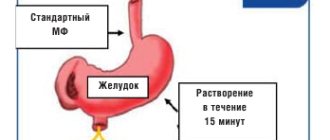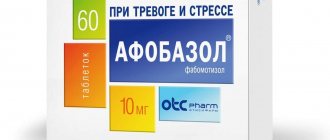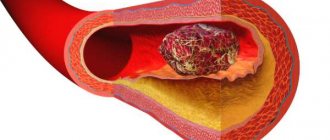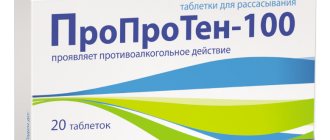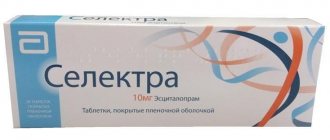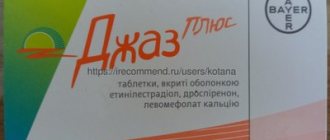Unfortunately, it is not always possible to control sugar levels with proper nutrition and physical therapy. Then medications such as Galvus Met come to the rescue. This drug belongs to the group of combined oral hypoglycemic agents. In this article we will look at the reviews of diabetics about Galvus Met.
Description of the dosage form
The pharmacy chain offers the medicine in the form of coated tablets, each of which contains two active ingredients: 50 mg of vildagliptin and 500, 850 or 1000 mg of metformin. Magnesium stearate, hyprolose, hypromellose, talc, titanium dioxide, macrogol 4000 and iron oxide are used as fillers.
Each blister contains 10 tablets. The records are packaged in boxes of 3 pieces; each Galvus Met package also contains instructions.
- 50/500 mg – oval tablets with a sharp edge in a yellow-pink coating. The abbreviation LLO is printed on one side and NVR on the reverse.
- 50/850 mg - similar tablet shape, only the shell is yellow-gray and the corresponding marking: SEH on one side and NVR on the other.
- 50/1000 mg - tablets that differ from the previous type in a more saturated shade of yellow with the addition of gray and abbreviations: NVR - on the front side and FLO - on the back.
Drug analogues
Analogs of "Galvus Meta" by pharmacological group include:
- "Avandamet" is a combined hypoglycemic agent containing two main components - metformin and rosiglitazone. The drug is prescribed for the treatment of insulin-dependent diabetes mellitus. Metformin is aimed at inhibiting glucose synthesis in the liver, and rosiglitazone is aimed at increasing the sensitivity of cell receptors to insulin. The average price for the drug is 210 rubles per package of 56 tablets at a dose of 500/2 mg. Analogues of Galvus Met should be selected by a doctor.
- "Glimecomb" is also capable of normalizing glucose concentrations. The drug contains metformin and gliclazide. This drug is contraindicated in insulin-dependent diabetics, people in a coma, pregnant women, those suffering from hypoglycemia and other pathologies. The average cost of the drug is 450 rubles per package of 60 tablets.
- "Comboglise Prolong" - contains metformin and saxagliptin. The drug is prescribed for the treatment of type 2 diabetes mellitus, after the lack of effectiveness of physical therapy and diet. This medication is contraindicated for persons who have hypersensitivity to the main components included in the drug, an insulin-dependent form of diabetes, are pregnant, minors, and also have kidney and liver dysfunction. The average price for the drug is 2,900 rubles per package of 28 tablets.
- "Januvia" is a hypoglycemic agent that contains the active component sitagliptin. The use of the drug normalizes the level of glycemia and glucagon. The dosage is determined by the attending physician, who will take into account the sugar content, general health and other factors. The drug is contraindicated for people with insulin-dependent diabetes and individual intolerance to the components. During treatment, headaches, indigestion, joint pain, and respiratory tract infections may occur. The average price of the drug is 1,600 rubles.
- Trajenta is commercially available in the form of tablets containing linagliptin. Reduces gluconeogenesis and stabilizes sugar levels. The doctor selects dosages individually for each patient.
- Vipidia is considered a hypoglycemic agent intended for monotherapy or combination treatment of type 2 diabetes. Available in tablet form, the highest daily dose is 25 mg, regardless of food. The hypoglycemic drug is prohibited for people with renal, hepatic, or heart failure; diabetic ketoacidosis and insulin-dependent diabetes are also contraindications. Side effects are similar to the negative effects of the drug "Galvus". Since there is no information about the effect on children and pregnant women, the medicine is not prescribed to them. The average price of Vipidia is 1,200 rubles.
- Ongliza is a good drug for maintaining fasting and postprandial blood glucose levels. Thanks to saxagliptin, the drug also controls glucagon. Can be used as a primary remedy or in combination with other drugs. The medicine is contraindicated in cases of insulin therapy, type 1 diabetes and ketoacidosis. The main side effects are headache, swelling, and sore throat. The average cost of the drug is 1900 rubles.
Galvus Met has many other similar products.
Pharmacological possibilities
The hypoglycemic potential of the drug is realized by two types of basic components, each of which has its own mechanism of action. Their comprehensive capabilities allow you to reliably control glycemia throughout the day.
Vildagliptin, a dipeptidyl peptidase-4 (DPP-4) inhibitor, increases cell sensitivity to insulin and increases its production. This result is ensured by vidagliptin stimulation of the production of proteins vital for the pancreas - glucagon-like peptide type 1 (GLP-1) and glucose-dependent insulinotropic polypeptide (GIP).- Metformin, a compound of the group of biguanides in the hydrochloride form, normalizes glycemic indicators by reducing the rate of absorption of carbohydrates in the small intestine, reducing the production of glycogen in the liver and increasing its utilization in peripheral tissues. The compound may cause hypoglycemia.
In addition, the active components of the metabolite control lipid metabolism, normalize total cholesterol, triglycerol and low-density lipids.
When the drug is used orally, vildagliptin and metformin enter the bloodstream through the intestinal walls, reaching the therapeutic norm in 25-30 minutes and being evenly distributed throughout the organs and tissues. Metabolic processes of the Galvus Met metabolite occur in the liver. Decay products are excreted by the kidneys in the urine. The period of time during which half of the consumed norm is removed is about three hours.
With complex therapy with two drugs at daily rates of metformin 1500-3000 mg and vildagliptin 50 mg, distributed over 2 applications, a significant decrease in blood sugar was recorded over the course of one year. At the same time, glycosylated hemoglobin levels decreased by 0.7% when compared with the control group, which received only metformin.
In diabetics who were on complex treatment with Galvus Met, no significant weight correction was recorded. Over 24 weeks of using the drug, a significant decrease in blood pressure was detected in hypertensive patients with type 2 diabetes. A minimal number of hypoglycemic cases was recorded.
When Galvus Meta was prescribed during insulin treatment (at a dose of 41 units), the level of glycosylated hemoglobin fell by 0.72% in diabetic volunteers participating in the study. Hypoglycemia in the experimental subgroup and in the subgroup that was given placebo did not differ in incidence.
With the parallel use of glimepiride (from 4 mg/day) with Galvus Met, a significant decrease in glycosylated hemoglobin levels was also recorded - by 0.76%.
Galvus Met®
In patients receiving insulin treatment, Galvus Met® cannot replace insulin therapy. Galvus Met® should not be used to treat type 1 diabetes or diabetic ketoacidosis.
Vildagliptin
Liver dysfunction
The use of the combination drug vildagliptin + metformin is not recommended for patients with clinical or laboratory signs of liver dysfunction, including patients with an increase in ALT or AST >3 x ULN before treatment.
Rare cases of liver dysfunction (including hepatitis) have been reported with the use of vildagliptin. These cases were usually asymptomatic, without clinical consequences, and after discontinuation of therapy, liver function tests returned to normal. Liver function should be examined before starting therapy with the combination drug vildagliptin + metformin, then monitored once every 3 months during the first year of use of the drug, and then periodically. If an increase in aminotransferase activity is detected, a re-examination should be carried out to confirm the result, and then biochemical indicators of liver function should be regularly determined until they normalize. If an excess of AST or ALT activity of 3 or more times the ULN is confirmed upon re-examination, the use of the drug should be discontinued. If jaundice or other signs of liver dysfunction develop while using the vildagliptin + metformin combination, therapy should be discontinued immediately. After normalization of liver function indicators, treatment with the drug cannot be resumed.
Metformin
Lactic acidosis
Lactic acidosis is a very rare but severe metabolic complication, most often occurring with a sharp deterioration in renal function, as well as with cardiorespiratory syndromes and sepsis. With a sharp deterioration in kidney function, metformin accumulates in the body, which increases the risk of developing lactic acidosis.
If dehydration occurs (eg, associated with severe diarrhea or vomiting, fever, or decreased fluid intake), a patient taking metformin-containing medications (eg, Galvus Met®) should immediately stop taking the above medications and seek medical attention.
In patients taking drugs containing metformin (for example, Galvus Met®), caution should be exercised when initiating therapy with drugs that can acutely worsen renal function (for example, antihypertensive drugs, diuretics, NSAIDs). Other risk factors include: alcohol abuse, liver dysfunction, inadequately controlled diabetes mellitus, ketoacidosis, prolonged fasting, conditions associated with hypoxia, and concomitant use of drugs that can cause lactic acidosis.
Diagnosis of lactic acidosis
The patient and/or caregivers should be informed of the risk of developing lactic acidosis. Lactic acidosis is characterized by acidotic dyspnea, abdominal pain, muscle cramps, asthenia and hypothermia followed by coma. If symptoms develop that suggest the development of lactic acidosis, the patient should stop taking metformin-containing drugs (for example, Galvus Met®) and immediately seek medical help. Laboratory and instrumental examination data: decreased blood pH (<7.35), increased lactate concentration in the blood serum >5 mmol/l, as well as an increased anion gap and an increase in the lactate/pyruvate ratio. If lactic acidosis is suspected, therapy with metformin-containing drugs should be stopped and the patient should be hospitalized immediately.
Monitoring kidney function
Before starting therapy, GFR should be determined, and this indicator should be monitored periodically during drug therapy. The use of metformin-containing drugs (such as Galvus Met®) is contraindicated in patients with GFR <30 ml/min; in the presence of conditions that can impair renal function, the use of the above drugs should be temporarily suspended.
Since metformin is largely eliminated by the kidneys, the risk of accumulation and development of lactic acidosis increases with the severity of renal impairment. Because older age may be associated with deterioration of renal function, in patients in this category the dose of metformin-containing drugs (such as Galvus Met®) should be carefully adjusted to select the minimum dose that provides adequate glycemic effect, with regular monitoring of renal function.
Interactions
Concomitant use of medications that affect renal function or the distribution of metformin
Caution should be exercised when used concomitantly with drugs that can affect renal function, have significant hemodynamic effects or affect the distribution of metformin in the body, such as organic cations excreted by the kidneys by tubular secretion.
The use of iodine-containing radiocontrast agents for intravascular administration
Intravenous administration of radiopaque iodine-containing agents can provoke the development of contrast-induced nephropathy, leading to the accumulation of metformin in the body and increasing the risk of developing lactic acidosis. Metformin-containing medications (such as Galvus Met®) should be temporarily discontinued before or during the procedure; Dosage should be resumed no earlier than 48 hours after the procedure, after receiving laboratory confirmation of stabilization of renal function.
Alcohol consumption
It has been established that ethanol enhances the effect of metformin on lactate metabolism. The patient should be warned not to abuse alcohol while using metformin-containing drugs (such as Galvus Met®).
Alcohol intoxication is associated with an increased risk of lactic acidosis, especially with prolonged fasting, malnutrition and impaired liver function.
Vitamin B12 content
It has been established that metformin causes an asymptomatic decrease in the concentration of vitamin B12 in the blood serum in approximately 7% of cases. Such a decrease in very rare cases leads to the development of anemia. After discontinuation of metformin and/or vitamin B12 replacement therapy, serum concentrations of vitamin B12 quickly normalize. In patients receiving metformin-containing drugs (such as Galvus Met®), general clinical blood test parameters should be monitored at least once a year. If deviations of hematological parameters from the norm are detected, the etiology of such disorders should be clarified and appropriate treatment should be carried out. Some patients (eg, patients with insufficient intake or malabsorption of vitamin B12 or calcium) are predisposed to decreased serum concentrations of vitamin B12. In such patients, determining the concentration of vitamin B12 in the blood serum at least once every 2-3 years can have diagnostic value.
Hypoxia
Cardiovascular collapse (shock), acute heart failure, acute myocardial infarction, and other conditions characterized by hypoxemia are associated with lactic acidosis and may also contribute to prerenal azotemia. If the above conditions occur, the use of metformin-containing drugs (such as Galvus Met®) should be stopped immediately.
Surgical interventions
During surgical procedures under general, spinal or epidural anesthesia (except for minor operations not associated with restriction of food and fluid intake), the use of metformin-containing drugs (such as Galvus Met®) should be discontinued.
Resumption of the drug is possible no earlier than 48 hours after the intervention or after the restoration of oral food intake after receiving laboratory confirmation of stabilization of renal function.
Patients with liver dysfunction
Since lactic acidosis, which is one of the HPs of metformin, has been reported in some cases in patients with impaired liver function, the combination drug vildagliptin + metformin should not be used in patients with liver disease or impaired biochemical parameters of liver function.
Deterioration of the condition of patients with type 2 diabetes who previously responded to therapy
If a deviation in laboratory parameters from the norm is detected or clinical symptoms of a deterioration in the general condition appear (especially when symptoms are not clearly expressed and blurred) in patients with a previous adequate response to therapy, laboratory diagnostics should be immediately carried out to identify ketoacidosis and/or lactic acidosis. If acidosis is detected, you should immediately stop using the drug and take the necessary measures to correct the patient’s condition.
Hypoglycemia
As a rule, hypoglycemia is not observed in patients receiving therapy only with the combination drug vildagliptin + metformin, but it can occur against the background of a low-calorie diet (when intense physical activity is not compensated for by the caloric content of food), or against the background of alcohol consumption. The development of hypoglycemia is most likely in elderly, weakened or malnourished patients, as well as against the background of hypopituitarism, adrenal insufficiency or alcohol intoxication. In elderly patients and in those receiving beta-blockers, the diagnosis of hypoglycemia may be difficult.
Reduced effectiveness of hypoglycemic drugs
In case of stress (fever, injury, infection, surgery, etc.) that develops in patients receiving hypoglycemic drugs according to the standard regimen, a sharp decrease in the effectiveness of the latter for some time is possible. In this case, it may be necessary to temporarily discontinue therapy with the vildagliptin + metformin combination and transfer to insulin therapy. Resumption of treatment with Galvus Met® is possible after the end of the acute period.
Fertility
There have been no studies of the effect of the combination drug vildagliptin + metformin on fertility in humans. In animal studies, vildagliptin at doses 200 times higher than recommended did not cause fertility problems.
There were no adverse effects on fertility in males or females when metformin was administered at doses of 600 mg/kg per day, which is approximately 3 times the recommended human dose (based on body surface area).
Features of pharmacokinetics
Vildagliptin
If you take the tablets before meals, the active ingredient is quickly absorbed, reaching its maximum 105 minutes after entering the stomach. When taking the medication with food, the rate of absorption decreases slightly.
The absolute bioavailability of the drug is quite high – 85%. The distribution of the metabolite between plasma and erythrocytes is uniform; it binds weakly to blood protein - only 9.3%.
The main method of drug elimination is biotransformation; 69% of the dose in the body is converted into the pharmacologically inactive metabolite LAY151. Vildagliptin is excreted through the kidneys (85%) and intestines (23%).
Representatives of different ethnic groups, male or female, and different body weights show approximately the same results on the pharmacokinetics of the drug.
In mild or moderate liver failure, the bioavailability of vildagliptin drops to 20%, and in severe forms it increases by 22%.
Instructions for use
Vildagliptin is a substance with hypoglycemic action.
The drug belongs to the group of stimulants of the pancreatic islet apparatus. The medication can be administered regardless of whether the stomach is full or empty. The presence of food does not affect the absorption process.
The medicine is recommended by the doctor for therapy based on the tests performed and the results obtained on the severity of the disease. The dosage is prescribed individually for each patient, so general norms are given for general information.
When conducting therapy using only one effective drug or during combined treatment using 2 drugs, the dosage should not exceed 50 and 100 mg once per day.
If severe diabetes is observed, an increased dose of 100 mg should be introduced.
Two-component therapy includes drugs:
- Vildagliptin + Metformin;
- Vildagliptin + Thiazolidinedione;
- Vildagliptin + Insulin.
The same dosage as for combination treatment, 100 mg, is required for daily administration for three-component therapy - Metformin + Vildagliptin + sulfonylurea derivatives.
A dose of 50 mg is administered into the body once a day (morning or evening) . At the required rate of 100 mg, the pills are consumed 2 times a day, after waking up and before bedtime.
If the expected improvement does not occur during the use of an increased dosage, the doctor decides to introduce additional medications from the two- or three-component treatment.
Indications
The medicinal substance is prescribed only for the treatment of patients suffering from type 2 diabetes mellitus . The drug is used as independent therapy or as part of combination drugs.
To cure an insidious disease, two active ingredients are required. In this case, the following additional drugs are isolated:
and its analogues.
- Insulin;
- Any medication that lowers plasma sugar levels.
Compound
Vildagliptin is the active ingredient contained in the drug under the trade name Galvus. The latter is produced in the form of a round-shaped dragee, white in color, with various engravings on individual sides.
The active substance in the pill contains 50 mg. Additionally, anhydrous lactose and magnesium stearate are used. Sodium carboxymethyl starch is slightly present.
Price
The active substance is the main component of Galvus and has a strong effect. Pharmacies in different regions sell the drug at a cost of 1,150 to 1,300 rubles.
Who is the drug indicated for?
The combination drug is developed for the treatment of diabetics with type 2 diabetes. There are different therapeutic regimens based on Galvus Meta.
- Monotherapy - to normalize sugar levels, one medication is used - Galvus Met.
- Separate use of the active components of Metformin and Vildagliptin as independent drugs.
- Complex therapy in parallel with sulfonylurea derivatives.
- Triple regimen with the addition of insulin to Galvus Meta.
- As a first-line medicine, used at the very beginning of drug therapy, when a low-carbohydrate diet and dosed muscle exercises do not lead to the desired result.
The degree of effectiveness of Galvus Meta is assessed by the rate of normalization of glycemia.
Similar drugs:
- Guarem Dosed microgranules
- Amaryl Tablets
- Victoza Solution for injection
- Metformin hydrochloride Substance-powder
- Metformin-Teva Oral tablets
- Berlithion Oral tablets
- Januvia Oral tablets
- Glucovance Oral tablets
- Langerin Oral tablets
- Siofor 850 Tablets
** The Drug Directory is intended for informational purposes only. For more complete information, please refer to the manufacturer's instructions. Do not self-medicate; Before starting to use Galvus Met, you should consult a doctor. EUROLAB is not responsible for the consequences caused by the use of information posted on the portal. Any information on the site does not replace medical advice and cannot serve as a guarantee of the positive effect of the drug.
Are you interested in the drug Galvus Met? Do you want to know more detailed information or do you need a doctor's examination? Or do you need an inspection? You can make an appointment with a doctor - the Euro lab is always at your service! The best doctors will examine you, advise you, provide the necessary assistance and make a diagnosis. You can also call a doctor at home . Euro lab clinic is open for you around the clock.
** Attention! The information presented in this medication guide is intended for medical professionals and should not be used as a basis for self-medication. The description of the drug Galvus Met is provided for informational purposes and is not intended for prescribing treatment without the participation of a doctor. Patients need to consult a specialist!
If you are interested in any other drugs and medications, their descriptions and instructions for use, information about the composition and form of release, indications for use and side effects, methods of use, prices and reviews of drugs, or you have any other questions and suggestions - write to us, we will definitely try to help you.
Treatment of Galvus Metom for pregnant and lactating mothers
Experiments on pregnant animals that were administered doses of vildagliptin 200 times higher than normal showed that the drug does not disrupt the development of embryos and does not have a teratogenic effect. The use of Galvus Meta at a dosage of 1/10 showed a similar result.
The effect of the drug on the human fetus has not been sufficiently studied, so it is not prescribed to pregnant women. Metformin passes into breast milk; there is no data on the penetration of vildagliptin.
In general, Galvus Met is not used during breastfeeding.
Composition, release form and action
Diabetes mellitus is a disease in which the metabolism of carbohydrates and water in the body is disrupted. As a result, insufficient production of the hormone occurs and, accordingly, sugar accumulates in the blood rather than being converted into glucose.
The drug "Galvus Met" is aimed at reducing the number of insulin injections and its portions. The description indicates that the medicine is manufactured in the form of pills 50/500, 50/850, 50/1000 mg. Dragees are packaged in packs of 3 blisters of 10 tablets. One Galvus Met 50 mg pill contains:
- active ingredients - vildagliptin (50 mg) and metformin (500, 850, 1000 mg);
- additional elements - E172, hyprolose, hypromellose, talc, E171, macrogol, E172 (yellow, red).
"Galvus Met" has the following effects:
- lowers sugar levels;
- affects lipid metabolism;
- reduces the totality of cholesterol, triglycerides and low concentrations of lipoproteins;
- Vildagliptin - increases insulin production;
- Metformin - normalizes the absorption of carbohydrates by the intestines, reduces the production of glycogen in the liver and enhances its destruction in peripheral tissues.
Who is the hypoglycemic agent contraindicated for?
Pathologies for which the metabolite is not prescribed:
- Individual immunity, hypersensitivity to any of the components of the medication;
- Type 1 diabetes – insulin-dependent disease of this form requires insulin;
- A few days before surgery, X-ray and radioisotropic examination, invasive diagnostics;
Acetonemia is a metabolic disorder characterized by the appearance of ketone bodies in biological fluids, in particular this occurs with hyperglycemia;- Kidney pathologies (in acute or chronic form), processes that provoke dehydration - severe dehydration of the body due to diarrhea or frequent vomiting, fever, infections (sepsis, diseases of the respiratory system);
- Liver dysfunction associated with conditions that reduce its performance (cirrhosis, hepatitis);
- Cardiovascular pathologies, heart attack, shortness of breath;
Alcoholism as a disease or one-time alcohol intoxication;- Hypocaloric nutrition, when up to 1000 kcal/day enters the body;
- Any period of pregnancy and lactation;
- Children - the safety and effect of the drug have not been established.
Before prescribing Galvus Meta, the doctor must check for any contraindications.
Contraindications
The drug should be used with caution in patients over 60 years of age. The instructions highlight contraindications:
- intolerance to the components of the composition;
- renal failure;
- dehydration, fever, hypoxia, infectious, bronchopulmonary diseases;
- myocardial infarction, respiratory, heart failure;
- liver dysfunction;
- coma;
- pregnancy, breastfeeding;
- 2 days before operations;
- type 1 diabetes mellitus;
- ethyl alcohol poisoning, chronic alcoholism;
- following a low-calorie diet;
- age up to 18 years.
How to use the medicine
The tablet must be swallowed whole, without chewing or dissolving, and washed down with a sufficient volume of water at a comfortable temperature. If you take the tablet with food, the risk of side effects is reduced.
Doses of Galvus Meta depend on the degree of sugar compensation, the results of previous treatment with analogues, and the duration of the disease. In any case, the treatment plan is drawn up by the doctor.
If the drug is prescribed for the first time, as an addition to an insufficiently effective diet and physical activity, its norm will be 50/500 mg (the first indicator is vildagliptin, the second is metformin). In the future, if the therapeutic effect is insufficient, which is determined by laboratory methods, the dosage can be adjusted.
When the patient is already familiar with the drugs (has taken them separately or in other combinations), one of the options is recommended - 50/850 mg or 50/1000 mg.
In adulthood or with developing kidney pathologies, a minimum dosage is usually recommended.
To assess the result of treatment with Galvus Met, you need to check your sugar levels (both at home, with a glucometer, and in the laboratory) regularly.
Compound
| Film-coated tablets | 1 table |
| active substances: | |
| vildagliptin | 50 mg |
| metformin hydrochloride | 500 mg |
| 850 mg | |
| 1000 mg | |
| excipients: hyprolose - 49.5/84.15/99 mg; magnesium stearate - 6.5/9.85/11 mg; hypromellose - 12.858/18.58/20 mg; titanium dioxide (E171) - 2.36/2.9/2.2 mg; macrogol 4000 - 1.283/1.86/2 mg; talc - 1.283/1.86/2 mg; iron oxide yellow (E172) - 0.21/0.82/1.8 mg; iron oxide red (E172) - 0.006 mg/-/- |
Side effects
Undesirable consequences are not recorded so often, but a diabetic should study the list before use.
- Gastrointestinal tract - dyspeptic disorders, heartburn, pancreatitis, metallic taste in the mouth, poor absorption of vitamin B12.
- CNS – loss of coordination, headaches, hand tremors.
- Liver and bile ducts – hepatitis and liver dysfunction.
- Musculoskeletal system – joint and muscle pain.
- Skin – blisters, swelling, dry skin.
- Metabolism – lactic acidosis (increased concentration of uric acid, acidic reaction of the environment).
- Allergies – skin rashes, itching, urticaria; in severe reactions - angioedema (swelling of the face and genitals) and anaphylactic shock (a sharp drop in blood pressure, accompanied by multiple organ failure).
Sometimes hypoglycemia develops with bouts of cold sweat and hand tremors. At the first symptoms, you should drink half a glass of sweet tea or juice and eat candy.
Prescription cases Galvus Meta
The drug is prescribed simultaneously with a special diet.
"Galvus Met" is prescribed for the following situations:
- Sugar disease of 2 types together with physical exercise and diet.
- Unsatisfactory result after therapy with Vildagliptin or Metformin alone.
- Combination with sugar-lowering medications based on sulfourea.
- Triple complex treatment with insulin, if the previous insulin therapy with Metformin did not achieve normal glycemia values.
- The initial stage of treatment for type 2 diabetes mellitus, if there is no effect from physical therapy, a special diet and for better control of blood glucose levels.
- After complex treatment with individual drugs “Metformin” and “Vildagliptin”.
special instructions
When prescribing medication, a diabetic should read the instructions himself. Special instructions will help avoid side effects.
- Galvus Met is not an analogue of insulin; this is important, first of all, for diabetics with insulin-dependent diabetes.
- When treating with the drug, regular monitoring of blood sugar (both laboratory and individual, using a glucometer) is required.
- Every month, laboratory methods evaluate the condition of the kidneys, liver, and lactic acid concentration.
- During treatment with Galvus Met, drinking alcohol is unacceptable - this can contribute to the development of lactic acidosis.
- Poor absorption of vitamin B12 caused by the use of medication can cause anemia and neuropathy.
- Children, pregnant and nursing mothers do not take Galvus Met.
The active components of the metabolite interact with many medications; when drawing up a treatment regimen, the doctor must be informed about all medications taken.- The effect of Galvus Meta on psychomotor reactions and the degree of concentration has not been studied. When working with machines and mechanisms during treatment with the drug, you must be extremely careful.
Pharmacies sell Galvus Met by prescription. Self-medication with medication based on the experience of friends or advice from the Internet is unacceptable.
Galvus or Metformin which is better
The number of people with diabetes is growing all over the world, and this is pushing scientists to search for new treatments. This is associated with increased consumption of sugar-containing products, decreased physical activity, and environmental degradation.
The presented drugs contain vildagliptin and metformin separately, together or in combination with other antidiabetic substances. Their action improves insulin secretion, cell sensitivity to glucose, and reduces blood sugar concentrations.
Galvus and its analogues are a fairly new remedy. It blocks the destruction of peptides responsible for the production of insulin and reduces the secretion of glucagon, which disrupts the functioning of insulin. Due to this, sugar returns to normal.
The effect of the drug stops when sugar levels return to normal, so it does not lead to hypoglycemia. The substance has a number of contraindications and minor side effects.
Metformin has been one of the most commonly used antidiabetic drugs since 1994. It reduces the release of glucose from the liver and improves tissue sensitivity to insulin. It also has a number of contraindications and side effects.
The most effective drug is considered to be one that combines these two substances. This gives longer lasting results.
Only a doctor should select, find a replacement for Galvus, and prescribe the dosage of medications. In this case, it is necessary to take into account contraindications, possible complications, and peculiarities of administration.
Why is diabetes considered incurable?
Diabetes always leads to fatal complications. High blood sugar is extremely dangerous.
Lyudmila Antonova gave explanations about the treatment of diabetes.
Was the article helpful?
Rate the material on a five-point scale!
If you have any questions or want to share your opinion or experience, write a comment below.
Recommendations for storage and cost of the medicine
According to the instructions, Galvus Met is suitable for use within 18 months from the date of release, subject to proper storage. Expired medication must be disposed of. A dark and dry place, inaccessible to children, with temperature conditions up to 30° C is suitable for storage.
The medication is available by prescription. For the medicine Galvus Met, the price is determined by the dosage:
- 50/500 mg – on average 1457 rubles;
- 50/850 mg - on average 1469 rubles;
- 50/1000 mg – on average 1465 rubles.
Even with one-time daily use, not all diabetics are satisfied with this cost; the most complaints come from pensioners with minimal incomes. However, Swiss products are always of impeccable quality and do not belong to the budget segment of hypoglycemic agents.
Price
The cost of tablets in Moscow will be:
| Drug dosage, mg | Number of pieces per pack | Pharmacy | Price, rubles |
| 50+1000 | 30 | Pills.ru | 1490 |
| Hello | 1615 | ||
| E Pharmacy | 1490 | ||
| Ver.ru | 1590 | ||
| Omnifarm | 1510 | ||
| Samson | 1620 | ||
| Neopharmacy | 1385 | ||
| 50+850 | Pills.ru | 1630 | |
| E Pharmacy | 1655 | ||
| Omnifarm | 1660 | ||
| Samson | 1530 | ||
| 50+500 | Pills.ru | 1635 | |
| E Pharmacy | 1650 | ||
| Hello | 1615 | ||
| Omnifarm | 1510 | ||
| Samson | 1630 |
Galvus Met - reviews from diabetics and doctors
On thematic forums, endocrinologists speak positively about the results of treatment with Galvus Met. It is not recommended to prescribe it for cancer problems, since DPP-4, an enzyme that suppresses the development of tumors, is inhibited by Galvus Met. Insulin is usually prescribed for pancreatic cancer. Patients have mixed reviews of Galvus Meta, the main point of dispute is price and quality.
Olga Grigorievna, Voronezh. For me, Galvus Met is a fairly expensive medicine. In addition, taking it caused nausea, heartburn, and abdominal pain. The doctor will suggest a replacement for me with simple Galvus with Glucophage. This treatment option and cost suit me.
Anatoly Petrovich, Tver. Who knows which medicine is stronger - Galvus Met or Janumed? I have been buying Galvus Met for many years, and then the endocrinologist suggested that I switch to Janumed, which is given out free of charge at the clinic. I tried new pills, my sugar went up a little. Now I don’t know whether I should save on my health or buy Galvus Met again, because the medicine is not cheap, and in retirement I now have other options.
Inna, Moscow. I have a serious job, I regularly have to undergo a medical examination. I have been suffering from type 2 diabetes for the last four years. I take Galvus Met at a dose of 50/1000 mg - I just take a pill in the evening. So far, glycosylated hemoglobin is not higher than 7%, and I am satisfied with the drug. Through the Department of Health, it is possible to ensure that Galvus Met is prescribed free of charge.
Information about the drug Galvus Met for its combined hypoglycemic effect on insulin and glycogen in the body is based on official instructions, but is provided for informational purposes only and cannot be used as a guide for diagnosis or self-medication.
Overdose
Vildagliptin is well tolerated in a daily dose of up to 200 mg. When taking 400 mg, muscle pain, paresthesia, fever, and increased lipase activity are observed. When consuming 600 mg, swelling of the extremities develops. Dialysis does not help in removing the active component.
Taking more than 50 g of metformin leads to intoxication. It is manifested by hypoglycemia, lactic acidosis, nausea, diarrhea, vomiting, abdominal pain, increased breathing, decreased body temperature, muscle pain, and dizziness. The danger is impaired consciousness, coma. For removal, hemodialysis is performed.

